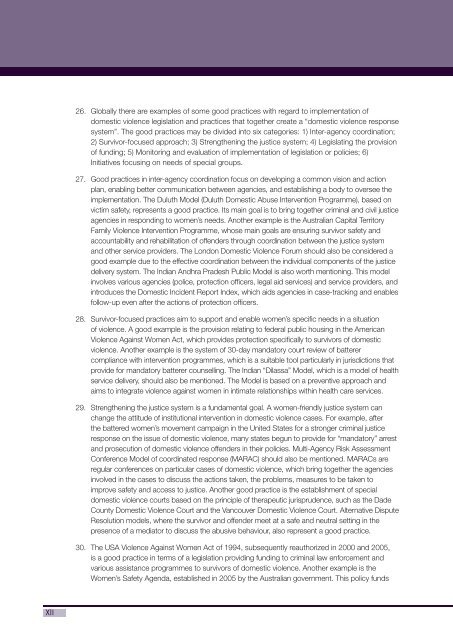Domestic Violence Legislation and its Implementation
Domestic Violence Legislation and its Implementation
Domestic Violence Legislation and its Implementation
Create successful ePaper yourself
Turn your PDF publications into a flip-book with our unique Google optimized e-Paper software.
EXECUTIVE SUMMARY<br />
XII<br />
26. Globally there are examples of some good practices with regard to implementation of<br />
domestic violence legislation <strong>and</strong> practices that together create a “domestic violence response<br />
system”. The good practices may be divided into six categories: 1) Inter-agency coordination;<br />
2) Survivor-focused approach; 3) Strengthening the justice system; 4) Legislating the provision<br />
of funding; 5) Monitoring <strong>and</strong> evaluation of implementation of legislation or policies; 6)<br />
Initiatives focusing on needs of special groups.<br />
27. Good practices in inter-agency coordination focus on developing a common vision <strong>and</strong> action<br />
plan, enabling better communication between agencies, <strong>and</strong> establishing a body to oversee the<br />
implementation. The Duluth Model (Duluth <strong>Domestic</strong> Abuse Intervention Programme), based on<br />
victim safety, represents a good practice. Its main goal is to bring together criminal <strong>and</strong> civil justice<br />
agencies in responding to women’s needs. Another example is the Australian Capital Territory<br />
Family <strong>Violence</strong> Intervention Programme, whose main goals are ensuring survivor safety <strong>and</strong><br />
accountability <strong>and</strong> rehabilitation of offenders through coordination between the justice system<br />
<strong>and</strong> other service providers. The London <strong>Domestic</strong> <strong>Violence</strong> Forum should also be considered a<br />
good example due to the effective coordination between the individual components of the justice<br />
delivery system. The Indian Andhra Pradesh Public Model is also worth mentioning. This model<br />
involves various agencies (police, protection offi cers, legal aid services) <strong>and</strong> service providers, <strong>and</strong><br />
introduces the <strong>Domestic</strong> Incident Report Index, which aids agencies in case-tracking <strong>and</strong> enables<br />
follow-up even after the actions of protection offi cers.<br />
28. Survivor-focused practices aim to support <strong>and</strong> enable women’s specifi c needs in a situation<br />
of violence. A good example is the provision relating to federal public housing in the American<br />
<strong>Violence</strong> Against Women Act, which provides protection specifi cally to survivors of domestic<br />
violence. Another example is the system of 30-day m<strong>and</strong>atory court review of batterer<br />
compliance with intervention programmes, which is a suitable tool particularly in jurisdictions that<br />
provide for m<strong>and</strong>atory batterer counselling. The Indian “Dilassa” Model, which is a model of health<br />
service delivery, should also be mentioned. The Model is based on a preventive approach <strong>and</strong><br />
aims to integrate violence against women in intimate relationships within health care services.<br />
29. Strengthening the justice system is a fundamental goal. A women-friendly justice system can<br />
change the attitude of institutional intervention in domestic violence cases. For example, after<br />
the battered women’s movement campaign in the United States for a stronger criminal justice<br />
response on the issue of domestic violence, many states begun to provide for “m<strong>and</strong>atory” arrest<br />
<strong>and</strong> prosecution of domestic violence offenders in their policies. Multi-Agency Risk Assessment<br />
Conference Model of coordinated response (MARAC) should also be mentioned. MARACs are<br />
regular conferences on particular cases of domestic violence, which bring together the agencies<br />
involved in the cases to discuss the actions taken, the problems, measures to be taken to<br />
improve safety <strong>and</strong> access to justice. Another good practice is the establishment of special<br />
domestic violence courts based on the principle of therapeutic jurisprudence, such as the Dade<br />
County <strong>Domestic</strong> <strong>Violence</strong> Court <strong>and</strong> the Vancouver <strong>Domestic</strong> <strong>Violence</strong> Court. Alternative Dispute<br />
Resolution models, where the survivor <strong>and</strong> offender meet at a safe <strong>and</strong> neutral setting in the<br />
presence of a mediator to discuss the abusive behaviour, also represent a good practice.<br />
30. The USA <strong>Violence</strong> Against Women Act of 1994, subsequently reauthorized in 2000 <strong>and</strong> 2005,<br />
is a good practice in terms of a legislation providing funding to criminal law enforcement <strong>and</strong><br />
various assistance programmes to survivors of domestic violence. Another example is the<br />
Women’s Safety Agenda, established in 2005 by the Australian government. This policy funds

















